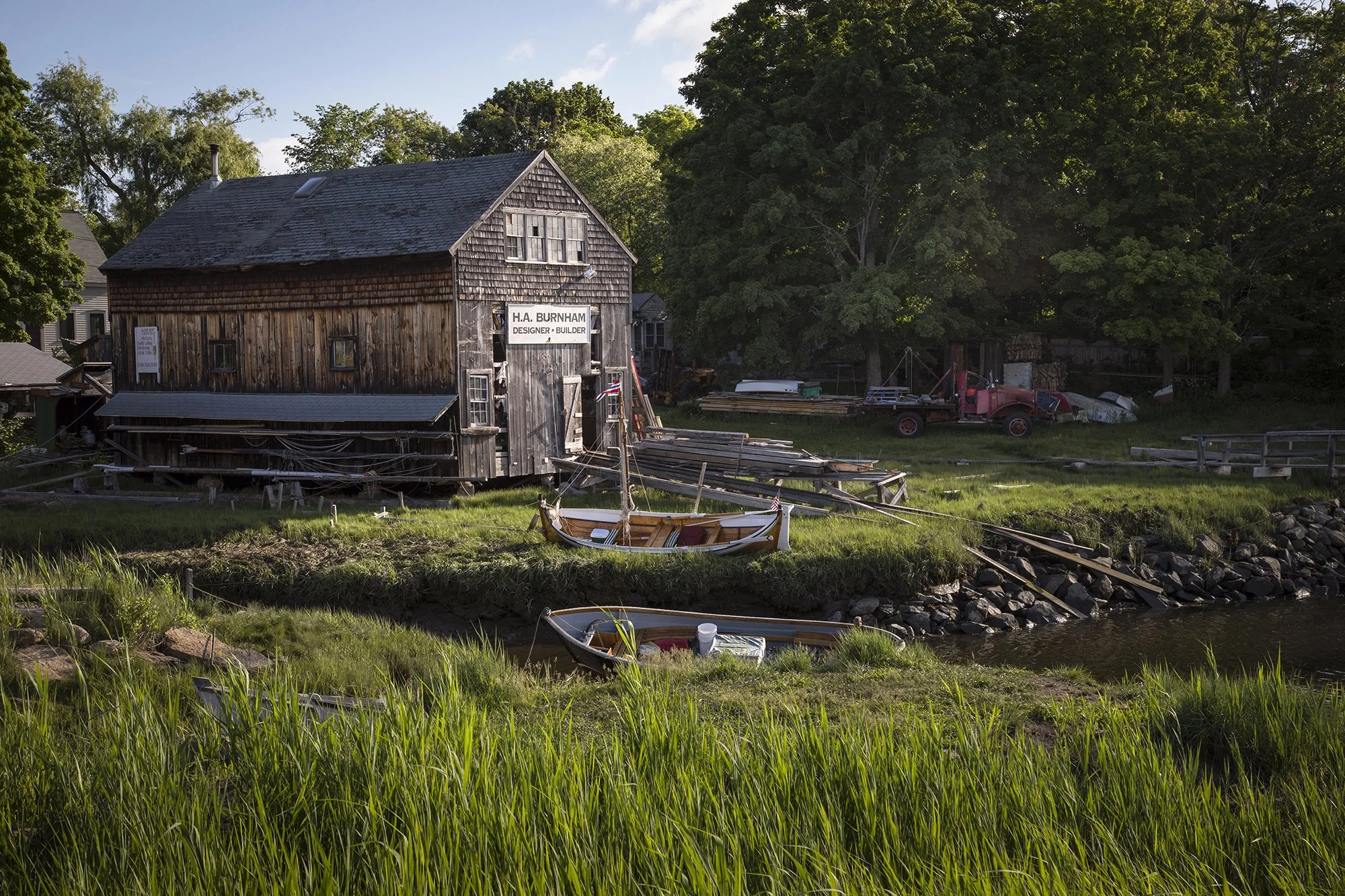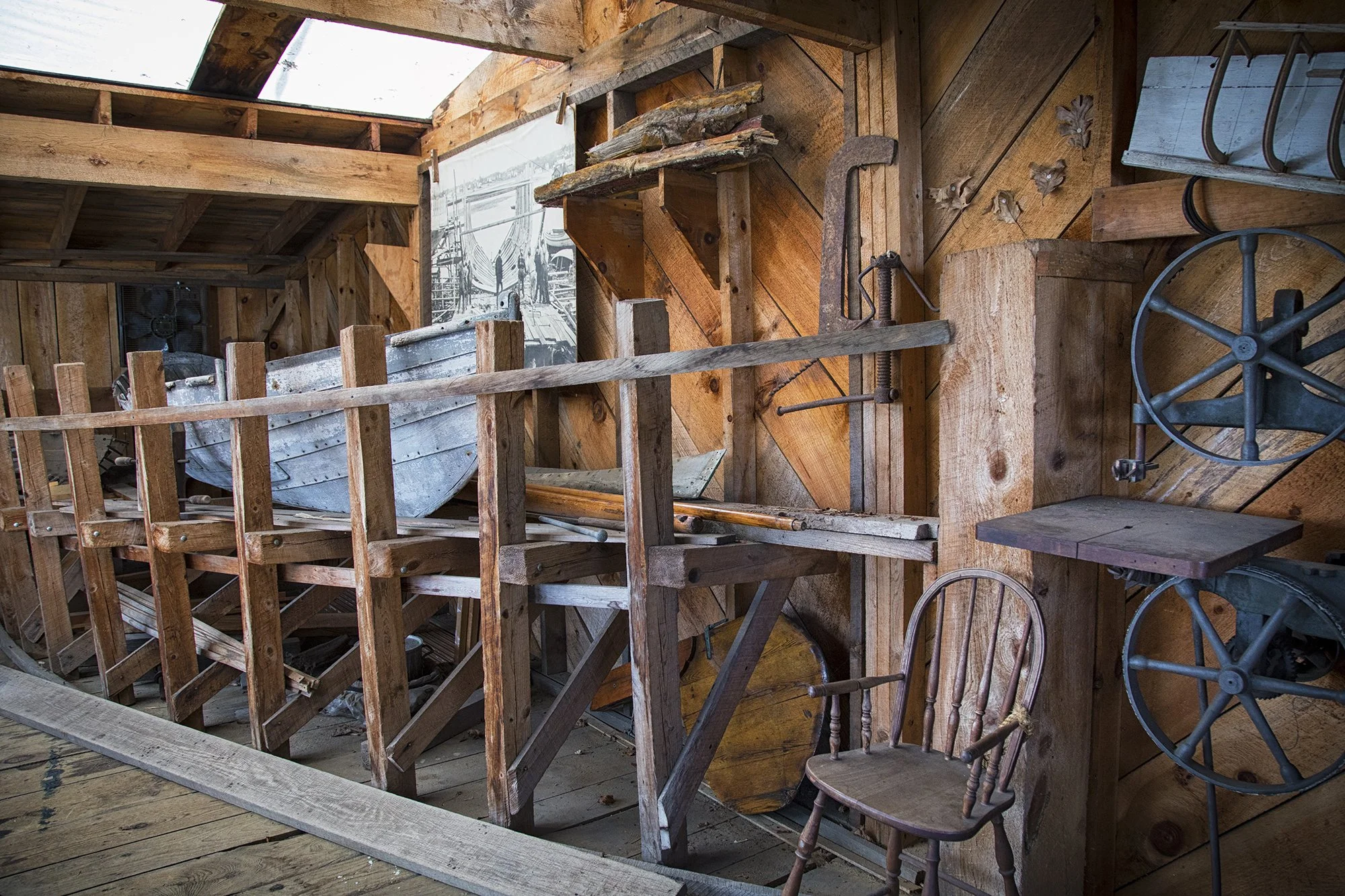Size Doesn’t Matter
Welcome to Cape Ann’s Miracle Mile. If Essex doesn’t have it, you don’t need it.
Essex, the smallest town on Cape Ann — and the second smallest in Essex County (Nahant is slightly smaller) — is just sixteen square miles in size, and two of those square miles are water.
Home to just over 3,600 residents, it’s a very special place.
The autumn light here smears itself like butter all around. In spring, a delicate green emerges from the marshes looking like lichen-stained milk paint. In winter, the marsh’s golden, crow-crossed expanse, with the Essex River slipping through like a girl’s lost ribbon, warms the starkest New England light.
The village of Essex is a blink-and-you’ll-miss-it stretch of Massachusetts Route 133, packed with antique shops and clam shacks, whose vistas extend to stunning panoramas of winding creek, tidal marshes, and not-too-distant sand dunes.
Dubbed the Essex River Cultural District by the Massachusetts Cultural Council — this one-mile stretch of Cape Ann scenic roadway is dotted by pocket parks with flower beds and granite benches, encouraging visitors to sit for a moment, enjoy the views, and take life a little bit … slower.
As far back as the 1600s, shipwrights pounded together vessels in Essex River boatyards, at a time when two-masted schooners ruled the fishing industry. Essex shipyards have launched over 4,000 of them — more than any place in the world — sliding hundreds of tons of craftsmanship right into the river.
Essex’ last schooner was launched in 1949 as fishermen moved away from what they began to call “sailing coffins.” Hundreds, if not thousands, of fishermen were lost on boats overloaded with fish that tipped in the gales of the north Atlantic.
The Essex Historical Society and Shipbuilding Museum sits adjacent to the 1668 shipyard. Inside you’ll find everything you need to know about this historic way of life. Outside, you’ll find the Evelina M. Goulart, one of seven Essex schooners that survived George’s Bank.
These days, antiquing and fried-clamming have replaced shipbuilding as the most popular activities in Essex, since engines finally defeated sails and Chubby Woodman started seriously frying clams.
When you’re ready to get wet (and we’re going to suggest you wait until summer), you can slip directly into the Essex River in a guided sea kayak tour with Essex River Basin Adventures (ERBA). They offer several kinds of river tours — including one by full moon! — which include a campfire with s’mores and cocoa on Crane Beach.
Alternatively, you could explore the river standing up — by paddleboard. Cape Ann SUP owners Anneliese Brosch and Dominic Olivo grew up on Cape Ann, and you can feel it in their shop. This isn’t SoCal board culture. This is Essex, where, natch, the business is run out of a 250-year-old building where tail-wagging Fila greets you at the door, the bell ringing from her collar announces your arrival.
Brosch and Olivo can give you the history of the barn, the best spots to put your board in, and the latest swell report. And you can take a little wisdom with you as you go, from the curbside chalkboard where Brosch posts fresh quotations every day. Social media, Essex-style.
“I’m still in love with the marsh. The Essex River? I couldn’t get enough of it when we first moved here. I can’t paint enough of it now.”
If getting into the river isn’t your thing, find yourself an artist who paints this beautiful scenery.
“I’m still in love with the marsh,” says artist Nancy Marculewicz, who settled in Essex more than forty years ago. “The Essex River? I couldn’t get enough of it when we first moved here. I can’t paint enough of it now.”
Marculewicz, a painter and monoprint artist who works in the unusual medium of gelatin, has pieces displayed at the Lahey Clinic, Governor’s Academy, Cabot Corporation, and the Cape Ann Museum. She says Essex is “a unique place — so many painters came to paint here, drawn by the openness, marshes, river, and light.”
About its historic charm, Marculewicz says it’s been “preserved ‘by default.’ It’s a little too far from the highway, with no true beach of its own, and so many of the old homes that the Essex shipbuilders built remain intact.”
The pinnacle of the Essex art scene comes every June when the Allyn Cox Reservation hosts its annual Art in the Barn, an event which Marculewicz created 29 years ago, and which has grown into a full-on three-day art festival featuring local food, drink, and music in addition to the original art exhibition and sale. Local artists donate their work and 50 percent of each sale goes towards benefitting Greenbelt’s land preservation mission.
Helen Tory, an Essex printmaker, agrees. “So many artists are drawn to the traditional landscape here. The access to the marshes, and the amazing views. It’s very inspiring.”
Tory exhibits her work in the quintessentially Essex shop and gallery, Rivers & Roads (formerly Walker Creek Furniture). Equal parts barn, shed, fish shack, and secret garden, Rivers & Roads is like a general store for regional culture. There are handcrafted farm tables and local fine art for sale, but there are also handmade twig trellises, Massachusetts honey, and some really good books. Owners Kristin and Chris Larson stock their favorite reads, new books and classics.
The Larsons met years ago at Gordon College, and both went on to become educators. Last year, they returned to Cape Ann with their three sons after five years in Colorado. Kirstin had grown up on a ranch there, and wanted her children to know what it meant to do a cattle drive.
The couple see Rivers & Roads as a Cape Ann community hub — a place to bring people together, whether it’s over a chance meeting, a workshop, or a book signing in their very hygge event space.
“I’m seeing a resurgence. We’ve never had this many young people coming into the shop. People are rediscovering antiques.”
Chris holds regular Saturday morning trellis-making workshops — twenty bucks covers “supplies and guidance.” On Thursday mornings in the summer there are free story, art, and nature times for young kids.
There are also multiple art openings throughout the summer, and an all-town croquet party. “Bring your blanket and croquet set if you have one!” says Kristin. And if that’s not enough, Rosalie Harrington, cook and owner of the legendary Marblehead restaurant, Rosalie’s, offers occasional cooking workshops.
The Rivers & Roads compound is also home to a group of 13 women artists known officially as the Essex Artists’ Collective. Their artwork has its own tiny house on the property.
In the back of the shop, through a Harry Potter-like warren of grapevines, is a small patch of sunlit garden, where two women from Gordon College are growing vegetables and cut flowers as part of their sustainable agriculture program.
Rivers & Roads is both energetic and tranquil — a place to browse and a place to learn, a place to visit, a place to find a gift, and a place to find your next good book. Thus, the shop’s carefully chosen tagline: “Good things for the journey.”
Duke the dog does a fine job of greeting guests at Perim Lang Antiques, just down the road. Perim Lang has been in Essex for 28 years, long enough to remember the golden years of Essex antiques — post-shipbuilding and pre-paddle boards.
The shop is owned by Thomas Lang and Leo Perim. Lang purchased his first antique with his parents when he was eight or nine. He remembers it well: a hand-blown Stoddard flask from New Hampshire.
Today, his two favorite pieces in his shop are a 1770 Chippendale secretary crowned with the original Chippendale-designed eagle finial and a 1925 Baccarat chandelier, influenced by the French and Russians living in Paris at the time. The tails of a circle of phoenix birds rise up to hold each candle.
Lang says antiquing is not yet an antique itself.
“I’m seeing a resurgence. We’ve never had this many young people coming into the shop. People are rediscovering antiques.” Lang believes that antiques give us a sense of place, a way to live the experience of history.
We’ve met Fila, Trapper, and Duke — now meet Eric Vennerbeck. He’s not a canine, but he does have something in common with that trio. He and his partner, Susan Kwapniewski, are the proprietors of Essex River Dogs, where the couple serves up tasty hot dogs from a cozy shingled stand with bright green trim next to the Richdale convenience store.
Go for the dog, stay for the conversation, and enjoy the breeze. If it’s not busy, ask Vennerbeck about his life before hot dogs.
After a childhood spent in Essex and Ipswich, Vennerbeck returned home five years ago following a long career in New York television and Broadway theater.
As a producer and director, he managed Dick Clark’s American Music Awards broadcast. He coached legendary boxer-turned-actor George Foreman and actor Tony Danza, as well as working closely with famed Broadway director, writer, choreographer, and dancer Michael Bennett on his musical Ballroom.
But Vennerbeck gets visibly excited when he talks about his tidy little business here.
“Most of my customers are locals. The couple from the kayak place come over, and we send people to them. When some of the kids first started coming here they couldn’t see over the counter. Now we can look them in the eye! This is why I came back here,” Vennerbeck says, his posture immediately relaxing when we start talking Essex.
“This is the best breeze in Essex,” Vennerbeck adds. “Right out our back door, and right up the river. It’s one of the rare spots where you can sit and always have a breeze.” Essex River Dogs has three broad picnic tables beneath an awning adjacent to the shop.
The locals have become equally attached. Kwapniewski shared this recent story: “We hadn’t opened for the season yet, and one woman, a regular, was anxious for us to start up. She ended up leaving a message at the Richdale, asking them to call her ‘as soon as the hot dog shop opened.’ It turns out, the woman’s father was in hospice, and all he wanted was just to come here and have a hot dog.”
Photographer Beth Pelton grew up in Massachusetts and now resides in a farmhouse with her family in rural New Hampshire.
► For more information, visit the Essex River Cultural District website.

























